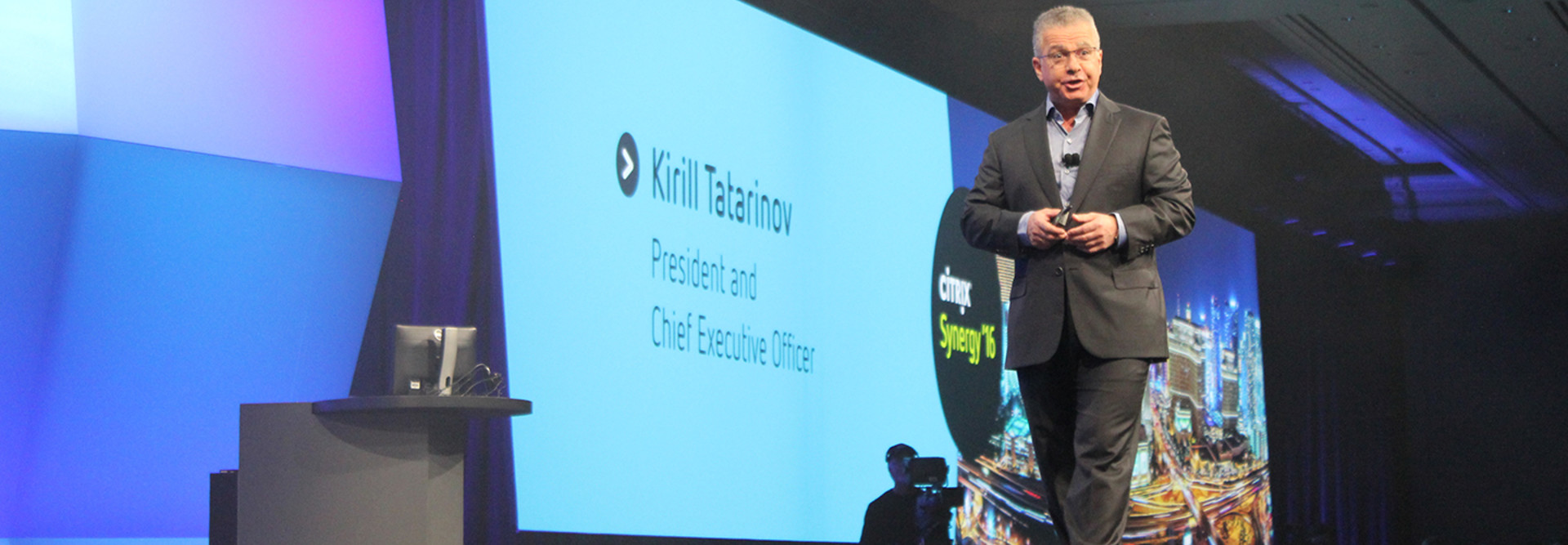Citrix Synergy 2016: Citrix Updates Cloud Tools, Promises to Unlock Productivity
The business technology world has been roiled by four “mega trends” in the past few years: the cloud, mobility, the Internet of Things and Big Data analytics, according to Citrix CEO Kirill Tatarinov. “The convergence of those four trends is what empowers digital transformation,” he said in Las Vegas during the opening keynote of the Citrix Synergy conference. “We see every industry, every company, large and small around the world, embracing digital transformation and making the incredible possible.”
During the keynote, Tatarinov unveiled several evolutions and updates to Citrix’s cloud and virtualization products, which he said will enable businesses to unlock productivity gains. He also disclosed that Citrix and Microsoft will expand their partnership to help business customers.
Tatarinov said Citrix is focused on helping businesses “stay more competitive, more agile, and ultimately able to deliver better services to their customers and their end users.”
Businesses are currently losing out on $2.7 trillion, a so-called “productivity gap,” as a result of not being as productive as they could be, Tatarinov said. IT workers and businesses generally are beset by a “crisis of complexity and cost” in enterprise IT, he said.
As a result, businesses have had to say no to new applications, and services are not as nimble as they could be. Citrix is focused on helping businesses instead say yes, Tatarinov said.
“We’re committed to reimagining how the world works,” Tatarinov said. “We believe technology must be a great liberator again. We believe that innovation must be measured to concrete gains in productivity.”
New Citrix Tools to Boost Productivity
During the keynote, Tatarinov discussed Citrix tools that he said will accelerate digital transformation efforts by delivering a unified Workspace as a Service (WaaS), which he said is “a new mode of working that is cloud-enabled” and gives users the “ability to access technology, applications and data anywhere in the cloud, with Citrix being the conduit.”
During a press conference after the keynote, Jesse Lipson, vice president and general manager of cloud services at Citrix, said that WaaS delivers data over the cloud, not only securely but also contextually. The new mode will deliver apps that are aware of whether a user is working on a notebook or smartphone.
Citrix unveiled new products and innovations for virtual desktop infrastructure and app virtualization, which the company says will deliver networking and secure file-sharing that can be accessed as cloud services from the expanded Citrix Cloud, or deployed on-premises on hybrid IT infrastructure.
Tatarinov talked up the “Citrix Cloud,” which helps businesses manage services from the cloud and unifies every major Citrix product needed to deliver a secure and dynamic digital workspace, including Citrix NetScaler, ShareFile, XenApp, XenDesktop and XenMobile. The company notes that these offerings are available individually, or can be accessed together as a unified WaaS solution.
Among the many announcements Tatarinov made were updates to Citrix’s enterprise-class file sync-and-share solution, ShareFile, which can run on any cloud, on-premises and hybrid IT infrastructure. ShareFile now has information rights management, which lets data security “follow the file” even as it leaves the ShareFile system and is accessed on unprotected devices, USB drives, email attachments and any other file sharing system. When a file is shared with rights management protections, access to the file requires ShareFile authentication — even after the file has been downloaded.
Citrix also showcased a new XenMobile feature, Secure Forms, which lets line-of-business managers and IT staff digitize specific processes and turn traditional paper forms into secure mobile mini-apps without writing a single line of code. Citrix says that as a result, IT staff will be able to securely streamline daily tasks, such as hospital patient requests and discharges, aircraft service inspections and insurance claims adjustment reports.
Tatarinov said during the press conference that Citrix is looking to expand to midmarket businesses and that ShareFile has been heavily embraced by the small to midsize business market. ShareFile offers simplicity and elegance to SMBs, he said, adding that Citrix wants to take what it has done with ShareFile and apply it across its entire portfolio.
Tatarinov said that Citrix’s channel partners play a significant role in how it approaches the small businesses market, because many of them are highly attuned to the SMB market. He said Citrix will “enable and empower them with specialized products” for small businesses.
Citrix Expands Partnership with Microsoft
Citrix and Microsoft are taking several steps to beef up their longstanding partnership. The companies are now working to integrate the Citrix XenMobile mobile application management platform, the Citrix NetScaler platform that enables public cloud connections and the Microsoft Enterprise Mobility Suite (EMS).
Brad Anderson, Microsoft’s corporate vice president of enterprise client and mobility, noted in a Microsoft blog post that Citrix will offer customers flexible options to deploy Windows 10 Enterprise within their organizations. Further, later this year, Citrix will offer customers who have licensed Windows 10 Enterprise (Current Branch for Business) on a per-user basis the option to manage their Windows 10 images on Azure through its XenDesktop virtual desktop infrastructure solution. The companies will help customers deploy virtual apps or desktops and accelerate Windows 10 adoption for businesses that are using Microsoft cloud solutions.
In other areas of partnership, Tatarinov said during the keynote that Citrix will enable a virtualized version of Skype for Business via Citrix XenApp and XenDesktop environments — important, he said, for companies in regulated industries that can only support Skype if it is deployed in a virtual environment so that chat records can be stored on servers.
Lipson added during the press conference that users can securely access data and documents on ShareFile; if they have an Office 365 license, they can collaboratively edit the document in the cloud with other users, and the document can be saved back to ShareFile afterward.







